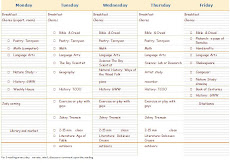How do you use the models? Do you have them read the model first, then rewrite it in their own words (a form of narration)? Is it more like copywork? Or are you trying to get them to emulate style or certain literary devices in the models?
The short answer would be: All of the Above. Especially if "you" is taken to mean "the standard way" or "how Classical Writing is designed".
If "you" means me in particular, you probably know by now that I never never -- hardly ever, at least -- do things that way they are written. So I ought to make a distinction between "how it is done" and "how we do it".
The way Classical Writing is designed -- well, I wrote a review for it once -- here. But briefly, there are two components -- analysis, and imitation.
Classical Writing divides the two components into daily tasks. Two daily sessions are recommended -- one for analysis (studying the model) and one for imitation (writing).
So the analysis component is divided up like this:
- Day One -- Read the story, bring in background information (context, vocabulary that is unfamiliar, etc) -- discuss the story.
- Day Two -- word analysis -- this would be phonics/spelling/dictionary skills, depending on the level the child is at (CW Aesop is meant to be used for 2nd to 5th graders but can be adapted to older levels)
- Day Three -- sentence analysis -- very simple grammar and mechanics for a young child, like capitalization and periods, then more complex for an older child)
- Day Four -- Copywork or Dictation. Take a section of the model and copy it (younger child) or write it from dictation (more advanced)
The imitation (writing) component is divided up like this:
- Day One -- overlaps with Day One above -- but you might do a retelling or make an outline.
- Day Two -- Write -- a younger child can dictate to Mom, an older child could write their own retelling.
- Day Three -- go over the written version and correct. ...gently, of course -- more with the attitude of finding one or more things to target and improve.
- Day Four -- write out revised version/final draft.
So the whole program includes almost all aspects of a language arts curriculum, and is sequential. You go from easy level study to more complicated. And as written, you can see it is fairly structured, though in a gentle way. The overall goal is to really study good literature and learn to recognize and easily employ excellent literary features.
There is some general information about the progymnasmata here, and here.
And there is a very informative message board dealing with Classical Writing.
Now me -- of course, I use structure as a road map. My kids have never liked to beat a topic to death. And they probably get it from me. Whenever we've tried a formal unit study, or analysis and imitation down to the micro-level as outlined above, it's been a failure.
So my plan is to use this structure as a generator, so to speak. Does that make sense? I like its comprehensive focus. You get literary discussion and analysis -- copywork/dictation -- grammar in the context of reading and writing -- and if you want, contextual studies (reading and researching more about the model's content and the writer's method and life). You could bring in graphic organizers and techniques from other reading and writing curriculums. You could pull in art. Or not.
Rather than study ALL those different elements every single week, I will probably pull in different things on different weeks. Unschooling for a couple of years taught me to watch my kids' reactions carefully. If they're into it, we can do more. If not, we'll skip parts or change them. This is how it works for us.
When we last used the progym, my kids sometimes wanted to make their own versions of the stories -- not just an imitation, but their own retelling, sometimes from the point of view of the adversary, or a comic parody, or whatever. Sometimes we went with that. Sometimes I had them do two, a "straight" one and a quirky one, so that we had both versions. You get the picture.
I hope this helps. I really appreciate the questions since they help me clarify my own thoughts. I don't know if you are interested in all this more than theoretically, Mom of 3, but I am thinking that your right brained learners, whose family culture teaches them to question and discern and evaluate everything, might not be attracted to what I would call the "pious" element in the CW curriculum. My own kids had a bit of an aversion to some of the 19th century and classical models -- sometimes the "moral" is pushed home pretty obviously.
That' s one reason I am planning to avoid the fables for now and some of the more heavy-handed tales and legends. ... and perhaps, bring in primary sources and small passages from excellent modern literature. And use the program more as a vehicle for literary analysis and discussion, than of micro-word-analysis and formal grammar instruction. Anyway, we'll see how it goes.



No comments:
Post a Comment